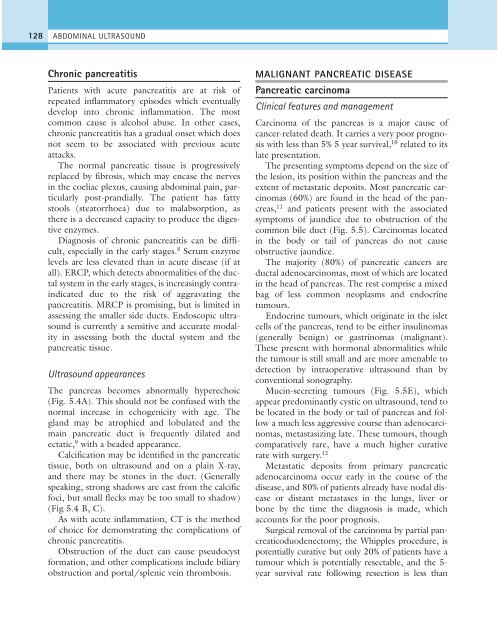9%20ECOGRAFIA%20ABDOMINAL%20COMO%20CUANDO%20DONDE
Create successful ePaper yourself
Turn your PDF publications into a flip-book with our unique Google optimized e-Paper software.
128<br />
ABDOMINAL ULTRASOUND<br />
Chronic pancreatitis<br />
Patients with acute pancreatitis are at risk of<br />
repeated inflammatory episodes which eventually<br />
develop into chronic inflammation. The most<br />
common cause is alcohol abuse. In other cases,<br />
chronic pancreatitis has a gradual onset which does<br />
not seem to be associated with previous acute<br />
attacks.<br />
The normal pancreatic tissue is progressively<br />
replaced by fibrosis, which may encase the nerves<br />
in the coeliac plexus, causing abdominal pain, particularly<br />
post-prandially. The patient has fatty<br />
stools (steatorrhoea) due to malabsorption, as<br />
there is a decreased capacity to produce the digestive<br />
enzymes.<br />
Diagnosis of chronic pancreatitis can be difficult,<br />
especially in the early stages. 8 Serum enzyme<br />
levels are less elevated than in acute disease (if at<br />
all). ERCP, which detects abnormalities of the ductal<br />
system in the early stages, is increasingly contraindicated<br />
due to the risk of aggravating the<br />
pancreatitis. MRCP is promising, but is limited in<br />
assessing the smaller side ducts. Endoscopic ultrasound<br />
is currently a sensitive and accurate modality<br />
in assessing both the ductal system and the<br />
pancreatic tissue.<br />
Ultrasound appearances<br />
The pancreas becomes abnormally hyperechoic<br />
(Fig. 5.4A). This should not be confused with the<br />
normal increase in echogenicity with age. The<br />
gland may be atrophied and lobulated and the<br />
main pancreatic duct is frequently dilated and<br />
ectatic, 9 with a beaded appearance.<br />
Calcification may be identified in the pancreatic<br />
tissue, both on ultrasound and on a plain X-ray,<br />
and there may be stones in the duct. (Generally<br />
speaking, strong shadows are cast from the calcific<br />
foci, but small flecks may be too small to shadow)<br />
(Fig 5.4 B, C).<br />
As with acute inflammation, CT is the method<br />
of choice for demonstrating the complications of<br />
chronic pancreatitis.<br />
Obstruction of the duct can cause pseudocyst<br />
formation, and other complications include biliary<br />
obstruction and portal/splenic vein thrombosis.<br />
MALIGNANT PANCREATIC DISEASE<br />
Pancreatic carcinoma<br />
Clinical features and management<br />
Carcinoma of the pancreas is a major cause of<br />
cancer-related death. It carries a very poor prognosis<br />
with less than 5% 5 year survival, 10 related to its<br />
late presentation.<br />
The presenting symptoms depend on the size of<br />
the lesion, its position within the pancreas and the<br />
extent of metastatic deposits. Most pancreatic carcinomas<br />
(60%) are found in the head of the pancreas,<br />
11 and patients present with the associated<br />
symptoms of jaundice due to obstruction of the<br />
common bile duct (Fig. 5.5). Carcinomas located<br />
in the body or tail of pancreas do not cause<br />
obstructive jaundice.<br />
The majority (80%) of pancreatic cancers are<br />
ductal adenocarcinomas, most of which are located<br />
in the head of pancreas. The rest comprise a mixed<br />
bag of less common neoplasms and endocrine<br />
tumours.<br />
Endocrine tumours, which originate in the islet<br />
cells of the pancreas, tend to be either insulinomas<br />
(generally benign) or gastrinomas (malignant).<br />
These present with hormonal abnormalities while<br />
the tumour is still small and are more amenable to<br />
detection by intraoperative ultrasound than by<br />
conventional sonography.<br />
Mucin-secreting tumours (Fig. 5.5E), which<br />
appear predominantly cystic on ultrasound, tend to<br />
be located in the body or tail of pancreas and follow<br />
a much less aggressive course than adenocarcinomas,<br />
metastasizing late. These tumours, though<br />
comparatively rare, have a much higher curative<br />
rate with surgery. 12<br />
Metastatic deposits from primary pancreatic<br />
adenocarcinoma occur early in the course of the<br />
disease, and 80% of patients already have nodal disease<br />
or distant metastases in the lungs, liver or<br />
bone by the time the diagnosis is made, which<br />
accounts for the poor prognosis.<br />
Surgical removal of the carcinoma by partial pancreaticoduodenectomy,<br />
the Whipples procedure, is<br />
potentially curative but only 20% of patients have a<br />
tumour which is potentially resectable, and the 5-<br />
year survival rate following resection is less than



